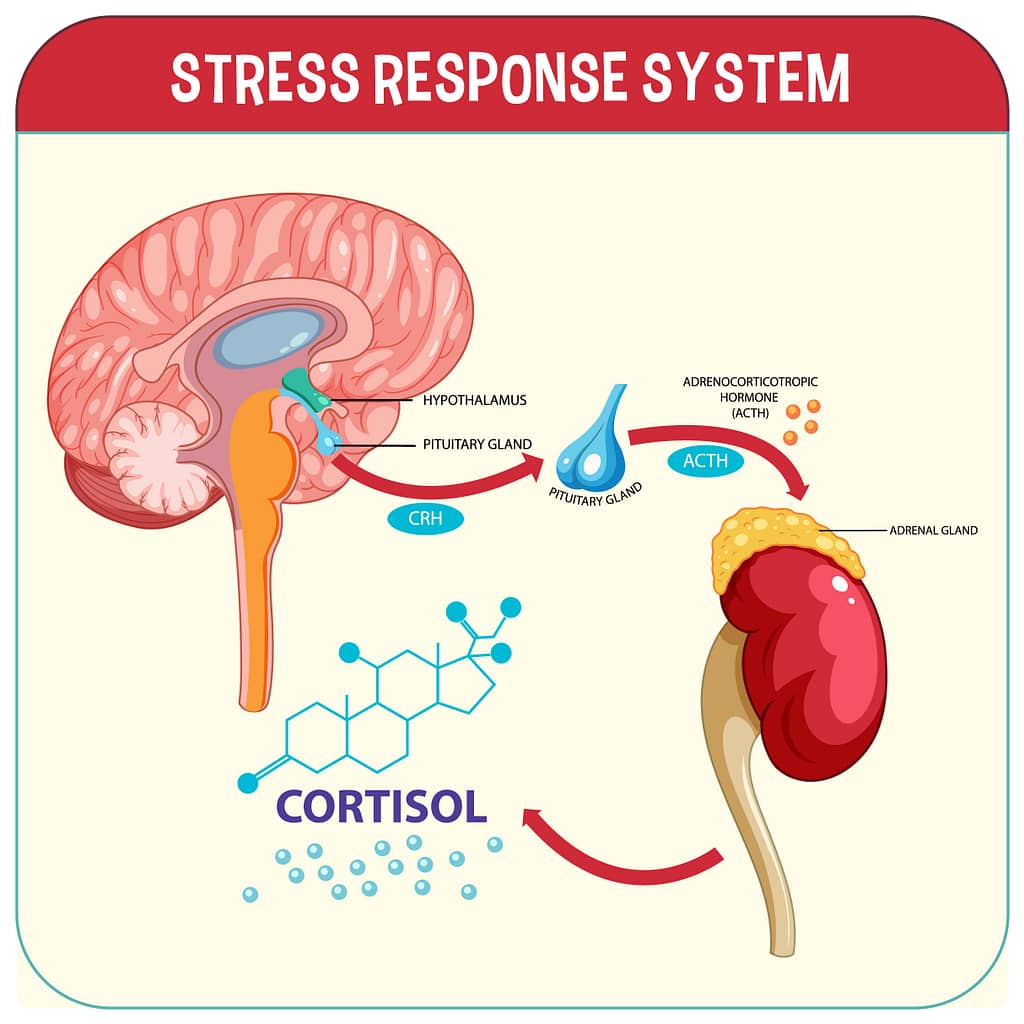how to fix a dysregulated nervous system
you wake up each morning feeling like you’re strapped into a rollercoaster you never wanted to ride. Your heart races, your stomach churns, and your mind races with worries. For many people, this isn’t just a nightmare; it’s the reality of living with a dysregulated nervous system.
The nervous system is like the body’s communication hub, responsible for keeping everything from our heartbeat to our stress levels in check. But when this system gets thrown off balance, it can cause all sorts of problems.
What’s a dysregulated nervous system?
Simply put, it’s when your body’s stress response goes into overdrive, leading to a bunch of symptoms that mess with your daily life. Think heightened anxiety, trouble sleeping, chronic pain, and tummy troubles.
In this article, we’re going to dive into what causes nervous system dysregulation, talk about the signs to watch out for, and most importantly, share some tips to help you find your way back to calm. So let’s buckle up and get ready to take control of your nervous system and find peace in the chaos.
Understanding the Nervous System:
The nervous system is like the body’s communication network, sending messages between different parts of the body and coordinating important functions. It has two main parts: the central nervous system (CNS) and the peripheral nervous system (PNS).
Central Nervous System (CNS):
This includes the brain and spinal cord. It’s like the command center, processing information, making decisions, and storing memories. The brain handles conscious activities like thinking and moving, while the spinal cord helps with quick reactions and sends messages back and forth.
Peripheral Nervous System (PNS):
This is all the nerves outside the brain and spinal cord, connecting them to the rest of the body. It splits into two parts:
– Somatic Nervous System: This helps us move voluntarily and feel things, like when we walk or touch something.
– Autonomic Nervous System (ANS):
This runs things we don’t control consciously, like our heartbeat or digestion. It has two parts:
– Sympathetic Nervous System (SNS): This gets us ready for action when we’re stressed or in danger. It makes our heart beat faster, our breathing quicker, and our muscles tense, preparing us to fight or flee.
– Parasympathetic Nervous System (PNS): This helps us relax and recover after stress. It slows our heart rate, calms our breathing, and helps with digestion, putting us in a state of rest and recovery.
Understanding how these parts work together helps us see how the nervous system can get out of balance and how we can help it get back on track for better overall health.
Causes of Nervous System Dysregulation:
Nervous system dysregulation can arise from various factors, both internal and external, disrupting its delicate balance. Here’s a breakdown of common contributors:
1. Chronic Stress: Extended exposure to stress can overactivate the sympathetic nervous system, leading to persistent arousal and dysregulation. High cortisol levels can hinder the body’s ability to relax, perpetuating imbalance.
2. Trauma: Physical, emotional, or psychological trauma can profoundly affect the nervous system, altering its responsiveness and triggering chronic dysregulation. Traumatic experiences, especially in early life, can shape the nervous system’s functioning and increase vulnerability to stress-related issues.
3. Genetics: Genetic predispositions can influence susceptibility to nervous system dysregulation. Certain genetic variations may impact neurotransmitter levels, stress response mechanisms, or brain regions involved in emotion regulation.
4. Environmental Factors: Toxins, pollutants, or adverse living conditions can impact nervous system function and contribute to dysregulation. Poor air quality, noise pollution, disrupted sleep, and inadequate nutrition can affect stress responses and disrupt balance.
5. Lifestyle Habits: Unhealthy choices like sedentary behavior, poor diet, substance abuse, and lack of sleep can worsen nervous system dysregulation. These habits disrupt hormonal balance, cellular function, and increase stress vulnerability.
6. Psychological Factors: Conditions like anxiety, depression, or PTSD directly affect nervous system function. Maladaptive coping strategies and unresolved trauma can perpetuate dysregulation.
7. Medical Conditions: Auto-immune disorders, chronic pain, neurological diseases, and hormonal imbalances can disrupt nervous system function. Inflammation, oxidative stress, and hormonal disturbances impact neurotransmitter activity and neural circuits.
Addressing these factors through stress management, therapy, lifestyle changes, and holistic approaches can help restore nervous system balance and promote overall well-being.
Signs and Symptoms of Dysregulated Nervous System:
Identifying the signs and symptoms of a dysregulated nervous system is crucial for seeking appropriate support. Here’s an overview of common manifestations:
1. Anxiety: Persistent feelings of worry, apprehension, or unease, leading to generalized anxiety disorder, panic attacks, or phobias.
2. Depression: Mood disturbances such as persistent sadness, hopelessness, and loss of interest, often accompanied by changes in appetite, sleep, and concentration.
3. Insomnia: Difficulty falling asleep, staying asleep, or waking up too early due to heightened arousal or intrusive thoughts.
4. Chronic Pain: Exacerbated pain perception contributing to conditions like fibromyalgia, migraines, or neuropathic pain.
5. Digestive Issues: Gastrointestinal symptoms like abdominal discomfort, bloating, constipation, diarrhea, or irritable bowel syndrome (IBS) due to disruptions in the gut-brain axis.
6. Fatigue: Persistent physical or mental exhaustion, impacting daily functioning and quality of life.
7. Hypervigilance: Heightened awareness, easily startled, or overwhelmed by environmental stimuli.
8. Emotional Dysregulation: Difficulty regulating emotions, leading to mood swings, emotional outbursts, and challenges in coping with stressors.
9. Cognitive Impairments: Difficulties with concentration, memory, and executive functions like decision-making and problem-solving.
Recognizing these signs and symptoms is the first step towards seeking support and implementing interventions to restore nervous system balance and overall well-being. Early intervention and comprehensive treatment approaches can significantly improve outcomes for those affected by nervous system dysregulation.
Healing Strategies for Dysregulated Nervous System:
To tackle nervous system dysregulation effectively, a holistic approach is key. Here are some practical strategies to promote relaxation, restore balance, and support overall well-being:
1. Mindfulness and Meditation:
– Engage in mindfulness meditation to cultivate present-moment awareness, reduce stress, and induce relaxation. Focus on your breath or bodily sensations to calm your mind.
2. Deep Breathing Exercises:
– Practice deep breathing techniques like diaphragmatic breathing or alternate nostril breathing to activate the parasympathetic nervous system and counteract stress responses.
3. Yoga and Tai Chi:
– Incorporate gentle movement practices such as yoga or tai chi into your routine. These activities combine movement, breathwork, and mindfulness to regulate the nervous system, reduce stress, and improve flexibility.
4. Therapy and Counseling:
– Seek support from therapists trained in trauma-informed care to address underlying emotional issues. Techniques like cognitive-behavioral therapy (CBT) or mindfulness-based stress reduction (MBSR) can be effective.
5. Healthy Lifestyle Habits:
– Maintain a balanced diet, prioritize regular exercise, and ensure adequate sleep to support nervous system health. Avoid substances like alcohol and drugs, which can exacerbate dysregulation.
6. Alternative Therapies:
– Explore alternative treatments such as acupuncture, massage therapy, or biofeedback to complement traditional approaches. These therapies can reduce muscle tension, alleviate pain, and promote relaxation.
7. Medication:
– In severe cases, medication prescribed by a healthcare professional may be necessary to manage symptoms. Antidepressants, anti-anxiety medications, or mood stabilizers can help regulate neurotransmitter activity and alleviate symptoms.
By integrating these strategies into your daily routine and seeking professional support when needed, you can effectively manage and heal a dysregulated nervous system, fostering resilience and well-being. Remember to be patient and compassionate with yourself throughout this journey of healing.
Self-Care Tips for Nervous System Regulation:
1. Mindful Breathing: Take a few minutes daily for deep breathing exercises to activate your body’s relaxation response.
2. Spending Time in Nature: Incorporate outdoor activities like walks in the park or gardening to calm your nervous system.
3. Practicing Gratitude: Keep a gratitude journal and write down three things you’re grateful for each day to promote positivity.
4. Engaging in Hobbies: Make time for activities you enjoy, such as painting, playing music, or reading, to relax and unwind.
5. Fostering Social Connections: Prioritize spending time with supportive friends and family to boost your emotional well-being.
6. Limiting Screen Time: Set boundaries on electronic device use, especially before bedtime, to improve sleep quality.
7. Regular Exercise: Incorporate physical activity like running, yoga, or dancing into your routine to regulate mood and reduce stress.
8. Healthy Eating Habits: Fuel your body with nutritious foods and limit caffeine and sugar intake to support overall well-being.
9. Prioritizing Sleep: Establish a consistent sleep schedule and bedtime routine to ensure 7-9 hours of quality sleep each night.
10. Seeking Professional Support: Don’t hesitate to reach out to a mental health professional if you’re struggling to manage stress or anxiety on your own. Therapy, counseling, or support groups can offer valuable resources and strategies for coping.
In this article, we’ve covered practical self-care strategies to support nervous system regulation and overall well-being. Here’s a recap of the key points:
– Emphasized the importance of various self-care practices such as mindful breathing, spending time in nature, practicing gratitude, engaging in hobbies, fostering social connections, limiting screen time, regular exercise, healthy eating, and prioritizing sleep.
– These strategies are effective in managing stress, anxiety, and other symptoms of nervous system dysregulation, promoting a sense of calm and balance in daily life.
It’s crucial to recognize when symptoms persist and seek professional help if needed. Therapy, counseling, or support groups offer tailored interventions and support to address underlying issues and develop coping strategies.
Remember, healing and restoring balance to the nervous system is a journey that requires patience, effort, and support. You’re not alone, and help is available. With perseverance and the right support, it’s possible to navigate challenges and cultivate resilience on the path to healing.
Additional Resources:
1. Books:
– “The Body Keeps the Score: Brain, Mind, and Body in the Healing of Trauma” by Bessel van der Kolk
– “Wired for Healing: Remapping the Brain to Recover from Chronic and Mysterious Illnesses” by Annie Hopper
– “The Polyvagal Theory in Therapy: Engaging the Rhythm of Regulation” by Deb A. Dana
– “Nervous System Reset: A Brain-Friendly Approach for Healing Trauma, Chronic Fatigue, and Other Chronic Conditions” by Annie Hopper
2. Websites:
– [Trauma Healing Institute]: Provides resources and information on trauma healing techniques and approaches.
– [The Polyvagal Institute]: Offers insights into the Polyvagal Theory and its applications for healing and regulation.
– [Anxiety and Depression Association of America (ADAA)]: Offers resources, support, and information on anxiety, depression, and related disorders.
3. Support Groups:
– [Heal Your Nervous System Support Group]: A Facebook group providing support and resources for individuals healing from nervous system dysregulation.
– [Trauma Survivors Support Group]: Online support group for trauma survivors offering a safe space for sharing experiences and finding support.
These resources offer valuable information, support, and community for individuals seeking to heal and regulate their nervous systems. Remember to explore and find what resonates best with your needs and journey toward well-being.
FAQs – How to Heal a Dysregulated Nervous System
1. How to Regulate a Dysregulated Nervous System:
– To regulate a dysregulated nervous system, try simple self-care practices like deep breathing, spending time outdoors, and engaging in hobbies. Seeking professional help, such as therapy or counseling, can also provide tailored strategies for regulation.
2. How to Heal the Nervous System from Trauma:
– Healing the nervous system from trauma involves therapy, support groups, and self-care. Therapies like trauma-focused therapy or EMDR can help process trauma, while self-care practices and social support aid in overall healing.
3. How Does Cocaine Affect the Nervous System:
– Cocaine affects the nervous system by altering neurotransmitter levels, leading to euphoria and heightened alertness. Long-term use can cause addiction and neurological complications.
4. Which is Not a General Function of the Nervous System:
– The nervous system’s general functions include sensing, thinking, and moving. It does not produce hormones, which is primarily the job of the endocrine system.
5. How Are the Nervous System and the Endocrine System Alike:
– Both systems regulate body functions and respond to stimuli. While the nervous system uses electrical signals for quick responses, the endocrine system uses hormones for slower, longer-lasting effects.
6. What is Not a Function of the Nervous System:
– The nervous system doesn’t produce red blood cells. That’s the job of the bone marrow, regulated by hormones from the endocrine system.
7. Why is the Nervous System Like a Telegraph:
– Just like a telegraph sends messages quickly over long distances, the nervous system rapidly communicates signals throughout the body using electrical impulses. This helps coordinate responses and maintain bodily functions.




